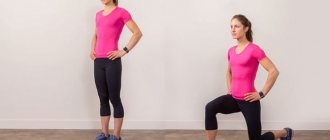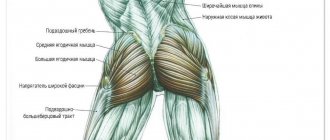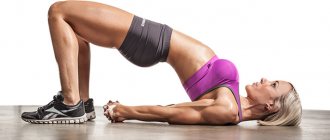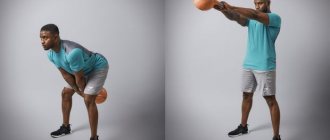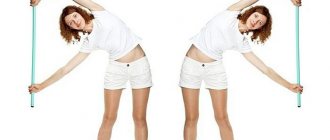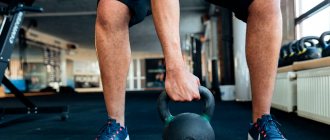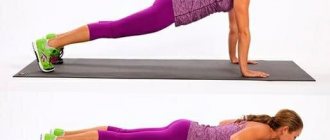Dear subscribers, we have a translation of a foreign article again! Yes, not a simple article, but to some extent “exotic”. Judge for yourself - exercises with weights for girls. It even sounds strange and unusual. Nevertheless, such complexes exist and help to properly work out various muscle groups. Material for strong girls who are not afraid of difficulties. Go!
Exercises recommended by trainer Tommy Caldwell that will have you working up a sweat.
- Tommy Caldwell: trainer, founder of Hybrid Training
- Model for the shoot: Bunny Azzopardi
- Photo: Paul Buceta
Do you want a workout that can squeeze the juice out of you in less than an hour? Then this material is for you. The six exercises in this article are recommended by a true functional training expert. These exercises are all you need to maximally use all the muscles in your body and train your cardiovascular system.
If you think that to perform them you just need to take a kettlebell and start swinging it, then you are not entirely right. Some of these exercises are designed for intermediate to advanced levels of fitness. So if you haven't worked out with kettlebells before, we recommend starting with easier exercises or asking a professional instructor to show you the ropes before you start training. Well, if you have already seen weights and managed to appreciate their convenience and functionality, this article will become a real guide for you.
Exercise 1: Swing
- Reps: 16-20
- Approaches: 3-4
Starting position: stand straight, feet shoulder-width apart. Hold the kettlebell in front with your arms extended downwards.
Execution: Bend your knees slightly and drive your hips back, swinging the kettlebell between your legs. Move your hips in the opposite direction and, straightening your knees, bring your arms straight with the weight to eye level. Keep your back straight throughout the movement and your shoulders back.
The swing is the first kettlebell exercise.
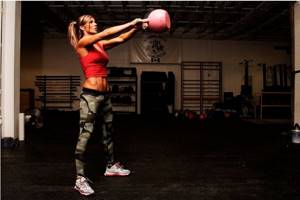
Raise the weight to eye level.
The magic of training with one kettlebell
With a kettlebell you can do everything the same as with a barbell or dumbbells. But the special shape and placement of its handle makes the kettlebell ideal for performing exercises such as swings, snatches and squat cleans.
There is an opinion that all work with weights comes down to swings and jerks, and they are, without a doubt, effective. In fact, one study by the Committee on Physical Education found that kettlebell exercises performed at 15-second intervals burned the calories equivalent to a 6-minute 1,400-meter run or uphill cross-country skiing. And this is already a serious statement.
However, the reduced training program is not the only end in itself. You can also combine exercises that require explosive muscle power with strength training to warm up your entire energy system, strengthen your heart, and increase muscle strength.
What weight should the weights be? The optimal weight of the kettlebell will be the one with which a person can perform 5 squat presses followed by lifting the kettlebell overhead. If a person can perform 10-15 reps of a kettlebell press using one arm and then raising it overhead, then perhaps this exercise will seem too easy for him, in which case he can increase the number of repetitions, which will make the training more effective. For female beginners, the “golden mean” is usually 4-12 kilograms. For men, usually 12-16 kilograms. For stronger or more experienced athletes, the weight of the kettlebell can be increased.
Standing kettlebell press: execution technique
If a person cannot perform the overhead press due to restrictions in the shoulder joint or thoracic spine, then I advise such people to exclude this set of exercises and perform exercises related to the lower body.
After a short dynamic warm-up of the muscles and joint mobility, the warm-up can be as simple as moving your joints in circles or performing one of the following exercises, which include body weight work and kettlebell exercises. The first group of exercises is based on the number of repetitions, the second is performed for a while. By changing workouts 2-3 times a week according to type A/B/A, you can achieve excellent results and master a huge number of exercises with weights.
In both cases, the load can be either increased or decreased. If someone does not want to distribute their training over time, then in this case one can start with the first exercise program and start with two series of each cycle. Over time, it will be possible to increase to three series and continue to increase in the future.
Exercise 2: Squats
- Reps: 10-12
- Approaches: 3-4
Starting position: Place your feet slightly wider than shoulder width. Grab two moderately heavy weights so that your hands are in an outward position (as shown). Keep your elbows close to your body and hold the weights at shoulder level.
Execution: Maintaining the position of your hands with weights, move your hips back and do a squat. You need to squat as low as you can, keeping your back straight with a slight arch at the bottom. Point your elbows straight down. Press your heels into the floor, and try to keep your knees level with your toes.
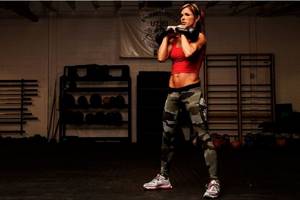
Weighted squats are great for training your glutes.
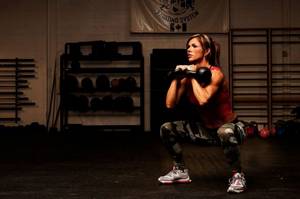
Keep your back straight.
What weight should weights be for women?
You can exercise both at home and in fitness centers, however, not all of them have these lightweight equipment, although it is possible to purchase 4 or 8 kg . This weight is quite sufficient for women, and regular exercise will help you get rid of extra pounds, promoting weight loss. The kettlebell is an excellent tool for strengthening muscles, developing strength and balance, giving the body flexibility and grace, and also for strengthening the heart muscle, because special cardio equipment is also necessary for a healthy heart.
For training, one weight is enough; athletic women who constantly work out in the gym or fitness center can take a weight weighing 8 kg, but for those who have not previously worked out not only with weights, but also on exercise machines, it is better to purchase a weight weighing no more than 6 kg.

Exercise 3: Push
- Reps: 10-12 on each side
- Approaches: 3
Starting position: Hold the kettlebell with one hand. Start the movement as if you were doing a swing from exercise 1: push your hips back and move the weight down between your legs.
Execution: swing the weight forward and up. Pull it closer to your body at shoulder level, and then push it up above your head, straightening your elbow. The handle of the weight should turn in your palm.
Repeat the exercise on the other side.
Tip: For this exercise, you should choose a light weight until you master the technique.
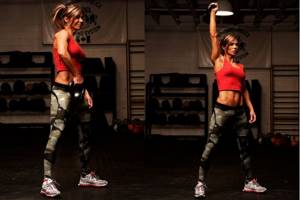
Use a light weight kettlebell until you perfect your technique.
What muscles work during kettlebell training?
Exercises with a projectile involve the muscles of the limbs, chest, abs and pelvis. Therefore, using kettlebells is suitable for overall body development. It is possible to use the apparatus for isotonic exercises, but the main goal is the development of all muscle groups.
When working with a projectile, the stabilizing muscles – adductors and abductors – are subject to load. Due to the shape of the projectile, the activation and use of abductors and adductors is required, while the motor skills of the groups are wider due to the varied number of movements. Traditional sports equipment - dumbbells and barbells - use the adductor and abductor muscles weaker during work.
Be sure to read: The best exercises to pump up beautiful and strong arms for a girl using dumbbells and without them
Therefore, during kettlebell lifting the following are especially active:
- leg muscles (quadriceps and adductors);
- back of the body (longissimus, gluteal, pelvic, biceps femoris muscles);
- body (press and stabilizing);
- arm muscles (especially the forearm).
To increase the effectiveness of exercise, you need to learn how to distribute the level of load throughout the body. Lack of footwork significantly reduces the results of the training.
Exercise 4: Press Up
- Reps: 10
- Approaches: 3
Starting position: stand up, holding two weights so that your hands are turned outward (same as for the squat in exercise 2).
Execution: Do a squat as usual. As you come out of the squat, press both kettlebells up overhead.
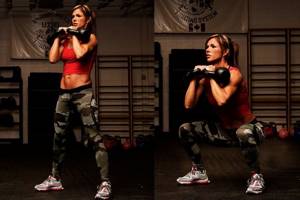
This exercise starts out like a regular squat.

As you come out of the squat, press both kettlebells up.
What muscles are involved?
Kettlebell squats, like other types of squats, are used to pump up the lower body. The exercise is classified as basic - it involves several large muscle groups. The main work here is performed by the quadriceps of the thigh, and the gluteal muscles receive a secondary load.
Additionally, the muscles of the back of the thigh, lumbar back, and calf muscles are involved in the movement. The biceps, shoulders and forearms receive static load.
Although this exercise involves less muscle volume than a classic squat, goblet squats are considered a safer option.
Exercise 5: Mill
- Reps: 10 per side
- Approaches: 3
Starting position: Stand with your feet shoulder-width apart, holding a kettlebell in your right hand. Turn your left foot at an angle of 45 degrees. Swing the weight down between your legs, and on the reverse movement, pull it toward your shoulder. Keep your back straight. Straighten your elbow and lift the kettlebell up above your head.
Execution: without bending your arm with the weight and your back, rotate at the hip joints so as to lower your straight body to your left leg until it is parallel with the floor. With your free hand, reach towards your foot and look at the weight. Stay in this position for a few seconds, then use your core muscles to return your body to the starting position.
Repeat on the other side.
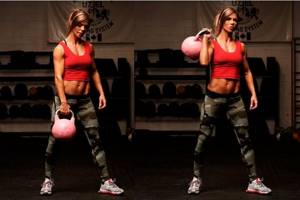
The mill is a fairly difficult exercise.
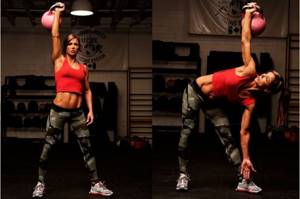
Arms are perpendicular to the floor, back straight.
Exercises with kettlebells
Russian kettlebell swings

Russian kettlebell swings differ from regular ones in that the kettlebell is not raised above the head, but only slightly above the shoulders. If you are unfamiliar with this exercise, it is best to start with simple Russian swings.
Exercise technique
- Stand straight, place your feet slightly wider than your shoulders.
- Grasp the weight with both hands, lean forward slightly and place the weight between your legs.
- The back should remain straight.
- Swing the kettlebell, bringing it to shoulder level. The movement starts from the hips, not the arms, which provides the force of the push.
- Lower the weight down, bringing it back between your legs, and repeat the exercise.
Swing a kettlebell with one hand
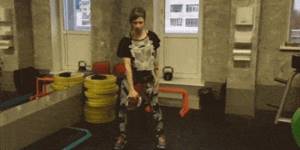
This movement is similar to the previous one. The only difference is that you work with one hand.
One-arm swings allow you to better pump up target muscle groups and are suitable for those who have already mastered two-handed kettlebell swings.
Bent-over kettlebell row

This exercise helps to pump up your back well. It will be an excellent replacement for dumbbell rows. Due to the shifted center of gravity of the kettlebell, performing the exercise will be a little more difficult.
Exercise technique
- Take two weights and lean forward with your back straight and knees slightly bent.
- Pull the weights towards your stomach. At the final point, the handles of the weights should be located in the stomach area.
- Pull the weights with your back muscles, not your arms.
- Keep your elbows close to your body, do not spread them out to the sides.
- Lower the weights to the starting position and repeat.
Eight kettlebells
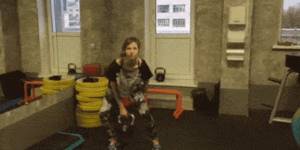
This exercise pumps up the core muscles well and also provides stress on the arms and legs. In addition, it looks quite impressive.
Exercise technique
- Stand with your feet wider than shoulder-width apart and hold the weight in your right hand.
- Bend your knees, lean forward slightly with a straight back and bring the weight between your legs at body level.
- Reach your left arm back and take the weight from your right hand.
- Move your left hand with the weight forward and move it back between your legs.
- Reach your right hand back and grab the weight from your left.
During this exercise, you seem to describe a figure eight around your legs, passing the weight from hand to hand. It may be difficult to coordinate the movements at first, but with a little practice you will get used to it.
Due to inertia, the exercise is performed quite easily, so you can take a heavier weight. The main thing is not to slouch your back, otherwise it can have a bad effect on your lower back.
Deep squats with a kettlebell
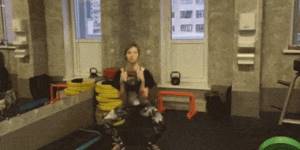
This exercise will help target your legs and buttocks. By using weights in the form of a kettlebell, you will achieve the desired shape much faster than doing repetitions without weight.
Exercise technique
- Stand up straight, hold a weight in front of your chest with both hands.
- Keep your elbows close to your body.
- Keeping your back straight and your pelvis back, do a deep squat.
- At the bottom of the squat, the hip joint should be below the knees.
- Return to starting position and repeat.
Jump Squats

If you want to work your leg muscles more and improve your explosiveness, try adding a jump to your squats.
Exercise technique
- Stand straight, place your feet shoulder-width apart, hold the kettlebell at your outstretched arms below.
- Squat until your thighs are parallel to the floor or slightly less.
- Jump up from the squat and repeat.
- To make the exercise more difficult, you can place plates or step pads under your feet. This will help deepen your squats, increase your range of motion, and increase your load.
Lunges with kettlebell push

During lunges, the muscles of the legs and buttocks are worked, and lifting the weights provides stress on the shoulders and arms.
Exercise technique
- Stand up straight, hold the kettlebell in your bent arm at shoulder level, elbow close to your body, arm turned with your palm facing your body.
- Lunge forward and at the same time raise your arm with the kettlebell above your head.
- Return to the starting position, lowering your hand with the kettlebell as you lift.
- Repeat on the other leg.
Russian twist with kettlebell
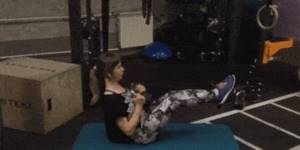
The exercise perfectly loads the core muscles, but it is quite difficult to perform and has a number of contraindications.
It should not be performed by those who have poorly developed rectus abdominis muscles, a stiff thoracic spine, or have back problems.
Exercise technique
- Sit on the floor on your ischial tuberosities, press the weight to your body and hold it in both hands, do not place your elbows to the sides.
- Raise your legs off the floor with your knees bent.
- Try to keep your back straight.
- Turn your body to the right and left without rounding your back or lowering your legs.
Mill with weight

This exercise requires some flexibility and good hip mobility. It simultaneously stretches the latissimus dorsi and strengthens the muscles of the core, arms and shoulders.
Exercise technique
- Stand with your feet shoulder-width apart, grab a kettlebell in one hand and lift it above your head.
- Bend to the side as far as the stretch allows. Ideally, you should touch your foot with your hand. The weight remains in the outstretched hand at the top.
- Return to starting position and repeat.
Lying down one-arm kettlebell raises

This exercise will help you tone your pectoral muscles, arms, and core muscles.
Exercise technique
- Lie on your back, bend your knees and place your feet on the floor.
- Hold the kettlebell in a bent arm, the shoulder lies on the floor, the elbow is pressed to the body, the angle between the shoulder and forearm is 90 degrees. The palm is turned towards the body.
- Press the kettlebell upward, turning your elbow to the side and your wrist with your palm facing your feet. At the extreme point, the weight is located above the chin.
- Lower the weight to the starting position and repeat.
Swing the kettlebell around yourself

This is another fairly effective exercise that perfectly pumps up the muscles of the core and arms.
Exercise technique
- Stand with your feet shoulder-width apart and hold a kettlebell in one hand.
- Bring the weight behind your back and grab it behind your back with your other hand.
- Bring your arm forward and grab the kettlebell with your other hand.
Kettlebell swings with side steps
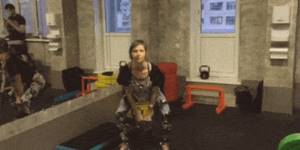
This is a universal exercise that combines regular kettlebell swings with movement around the gym. Great cardio for those who are tired of the treadmill.
Exercise technique
- Perform a Russian kettlebell swing. When the weight is at the top point (chin level), place your right foot next to your left, connecting them together.
- As the kettlebell lowers from the top, step sideways with your left foot, placing your feet shoulder-width apart.
- When the weight passes between your legs and goes up again, place your right foot next to your left and connect them together.
- Repeat this exercise on one side and then the other. To go to the right, you need to put your left foot down during the swing, and when the weight goes down, step with your right foot.
Deadlift with kettlebell
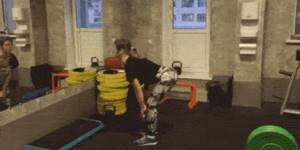
This exercise perfectly pumps up the buttocks and hamstrings. The load also goes to the core muscles.
Exercise technique
- Stand straight, feet shoulder-width apart, holding a kettlebell in both hands.
- Tilt your torso, push your pelvis back and lower the kettlebell to the floor.
- Keep your back straight while bending.
- Return to the starting position, tensing your buttocks and abs.
- Repeat the exercise.
Lifting a kettlebell onto the shoulder
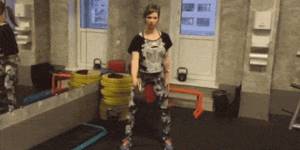
This is a fairly challenging exercise, so try it with light weights first and add pounds very carefully. When performed correctly, the exercise provides stress to the legs, buttocks and back.
Exercise technique
- Place the kettlebell between your legs, lean towards it with your back straight and grasp the kettlebell with one hand.
- Bring the kettlebell between your legs behind your body, gaining momentum, and then swing it up to shoulder level, turning your arm so that your palm is facing your body.
- The elbow should be close to the body, the wrist continues the line of the arm, without bending. The weight seems to hang on the indentation between the thumb and the rest of the fingers.
- Lower the weight so that it passes between your spread legs and bring it up again.
Standing two kettlebell press
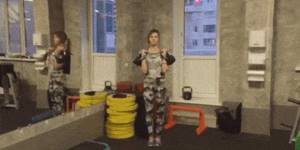
This exercise will perfectly pump up the upper body: arms, back and shoulders. It also involves the core muscles.
Exercise technique
- Take two weights and throw them over your shoulders. The elbows are close to the body, the palms are directed towards each other.
- Press the weights upward, turning your palms forward so that at the top point the weights are located behind your hand.
- Lower the weights to the starting position at shoulder level and repeat the exercise.
One-arm kettlebell snatch
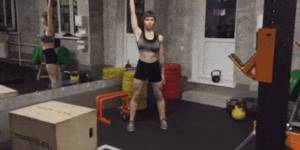
This is not only a strength exercise, but also a cardio workout. If you choose the right weight, the very first set will greatly raise your heart rate. In addition, the exercise pumps up the shoulders, chest and core muscles.
Exercise technique
- Stand with your feet slightly wider than shoulder-width apart and place the kettlebell on the floor between your legs.
- Lean towards the kettlebell with a straight back, moving your pelvis back, grab it with one hand, and move the other back behind your back.
- Bring the kettlebell between your legs, swinging it back a little, and then swing it forward.
- Snatch the weight, bringing it above your head. The palm faces forward, the weight is behind the hand.
- Lower the kettlebell down so that it passes back between your legs again, and then repeat the upward jerk.
Kettlebell plank + alternate rows with each arm
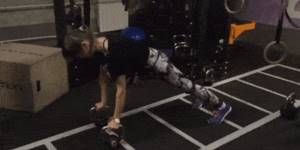
Try to complicate and diversify the plank with kettlebells. This exercise primarily develops the abs, and due to alternate lifting of weights, it puts stress on the arms and back.
Exercise technique
- Get into a plank position with your hands on the handles of the weights.
- Raise one arm with the kettlebell.
- Try to keep your body straight while lifting the weights, do not rotate your hips. Ideally, the hips should be firmly fixed.
- Pull the weight with your back muscles, not your arms.
- Lower the kettlebell to the floor and raise your other arm.
Turkish get-up with kettlebell

This is a very interesting exercise. There is quite a lot of movement in it, so you will have to make a lot of effort to maintain your balance. With its help, you can provide stress to all the muscles of the body.
Exercise technique
- Lie on the floor with your arm extended above your head. If you are holding a kettlebell in your right hand, bend your right leg and place your foot on the floor.
- Raise your body, holding the kettlebell above your head, into a glute bridge. Lean on your right leg, straighten your left and extend it to the side.
- Place your left leg behind your right and place it on your knee. You will find yourself at the bottom of a lunge with the kettlebell overhead.
- Stand up from a lunge and place your feet shoulder-width apart.
- Return to the starting position, going through all the steps in reverse order: lunge, glute bridge, floor position with bent leg and kettlebell in outstretched arm.
- Repeat the exercise.
Kettlebell push-ups
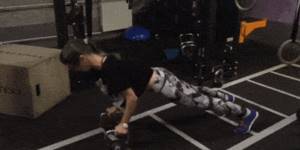
This exercise works the same muscles as regular push-ups: chest, triceps, core. Due to the fact that the hands are not on the floor, but on the handles of the weights, the exercise becomes more difficult.
Exercise technique
- Stand in a prone position with your hands on the handles of the weights.
- Do a push-up, keeping your elbows close to your body.
- Try to tighten your abs and buttocks to keep your body straight.
Kettlebell push-up
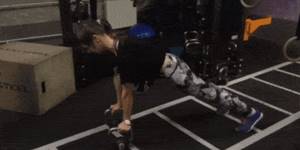
This exercise combines the two previous ones, and therefore it is even more difficult and effective for pumping up the arms, back and chest.
Exercise technique
- Stand in a lying position, leaning on the handles of the weights.
- Do a push-up.
- Pull one arm with the kettlebell toward your waist. Keep your elbow close to your body and try to pull the weight with your back muscles.
- Place the hand with the weight on the floor and repeat the exercise with the other hand.
